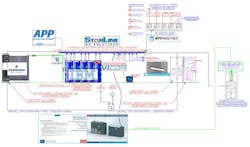400 Vdc Power Distribution For Data Centers Emerges
INTELEC 2014’s 400 Vdc demonstration included all the components necessary for a fully functioning 400 Vdc deployment for data center environments, including power supplies and conversion systems, busway, PDUs, servers, network switches, power connectors and breakers. More than 20 manufacturers were represented (Fig. 1).
Related Articles
- 400-V dc distribution is rising in telecom
- International Telecommunications Energy Conference (INTELEC)
- 380 VDC Input Supplies Enable Data Centers to Use HVDC Power Distribution
In the past, the ready availability of UL-certified, production-level equipment has been a challenge to 400 Vdc adoption. However, Emerson Network Power and Vicor Corporation hosted a demonstration of 400 V technology at INTELEC 2012, and equipment availability has increased dramatically since then.
Interest in 400 Vdc power distribution remains high for the right applications, because it presents several potential advantages over traditional 480 Vac architectures. In data centers, it simplifies the power chain, which improves availability and potentially efficiency compared to 480 Vac power. The INTELEC 2014 demonstration illustrated those advantages while showing the flexible, plug-and-play architecture that makes 400 Vdc power easy and safe to deploy and configure.
The 2014 demonstration is an outgrowth of one of the first studies on the use of 400 Vdc power distribution that was presented at the 2007 INTELEC conference [1]. In a typical data center, less than half the energy consumed is delivered to the compute load, with the rest lost in power conversion, distribution and cooling. Traditionally power distribution has been at 400/480 Vac in data centers. Higher voltage DC has been proposed as an energy efficient distribution option for both types of facilities, and this 2007 study presents an analytical evaluation of several data center power delivery architectures over a range of loads, showing that a 400 V facility-level DC distribution option is the most efficient.
A summary of the 2007 study stated that: “400 Vdc provides the highest efficiency, cost effective solution to powering the data center. Intel’s case study of a proposed 400Vdc power distribution compared to the planned design based on conventional 480VAC distribution for a potential addition of a 5.5 MW expansion module to an existing data center reveals improved energy efficiency over a broad load range. The 7% to 8% energy savings alone provide reason enough to consider the switch. When you consider the additional benefits of 400 Vdc power distribution and the ease of integration with alternative energy generation, the argument becomes even more compelling. The 15% less capital cost, 200% reliability improvement, and 33% facility space savings, make a strong case for the use of DC power distribution to not just improve the energy efficiency of future data centers, but also to reduce the costs of building them and improve the overall reliability and availability of their systems. What’s more, the transition to 400VDC power distribution would be rather easy, requiring just the manufacture and certification of a few simple components that are easily derived from current products. In fact, the certification is no different from what would be required to certify costlier high-efficiency 480VAC alternatives. Given the imperatives to save cost, save energy and reduce carbon emissions, 400 Vdc is not only compelling, it appears to be inevitable.”
Fig. 3 compares the performance of the 400 Vdc and 480 Vac systems described in the 2007 study [1]. It was estimated that the proposed 400 Vdc power distribution would deliver approximately a 7% energy savings over the 480 Vac design. (Actual figures were 7.7% savings at 50% load and 6.9% savings at 80% load.) The main source of these savings was the elimination of three power conversion steps and also elimination of power factor correction for the PSU.
Fig. 4 shows Vicor’s ChP 6123 BCM that accepts a 380 Vdc input and provides a 48 Vdc output.
Reference
1. Tomm Aldridge, Annabelle Pratt, Pavan Kumar, Dwight Dupy, Guy AlLee, Intel Labs, “Evaluating 400 V Direct-Current for Data Centers,” A case study comparing 400 Vdc with 480-208 Vac power distribution for energy efficiency and other benefits.
About the Author

Sam Davis
Sam Davis was the editor-in-chief of Power Electronics Technology magazine and website that is now part of Electronic Design. He has 18 years experience in electronic engineering design and management, six years in public relations and 25 years as a trade press editor. He holds a BSEE from Case-Western Reserve University, and did graduate work at the same school and UCLA. Sam was the editor for PCIM, the predecessor to Power Electronics Technology, from 1984 to 2004. His engineering experience includes circuit and system design for Litton Systems, Bunker-Ramo, Rocketdyne, and Clevite Corporation.. Design tasks included analog circuits, display systems, power supplies, underwater ordnance systems, and test systems. He also served as a program manager for a Litton Systems Navy program.
Sam is the author of Computer Data Displays, a book published by Prentice-Hall in the U.S. and Japan in 1969. He is also a recipient of the Jesse Neal Award for trade press editorial excellence, and has one patent for naval ship construction that simplifies electronic system integration.
You can also check out his Power Electronics blog.




